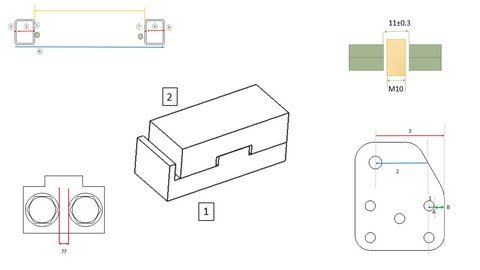
Basics Of Tolerance Stack-Up Analysis And Fits With Gd&T
Last updated 2/2022
MP4 | Video: h264, 1280x720 | Audio: AAC, 44.1 KHz
Language: English | Size: 832.63 MB | Duration: 3h 13m
Learn About Tolerances Stack-up Analysis and about fits in engineering with multiple examples with GD&T for mechanical
What you'll learn
The Basics of Limits and Fits
How to do a simple Tolerance stackup analysis
How to do a Tolerance stackup analysis with GD&T
What is statistical tolerancing
How to Perform 1 D Tolerance stack up analysis
Requirements
Basic understanding of engineering design
One section requires understanding of Basics of GD&T - Concepts like Virtual condition , boudnaries, Material modifiers, Datum Shift
Description
Understanding Tolerances and tolerancing schemes is a very important part of Mechanical design .In most cases Tolerances are directly detrimental to the functional performance of a mechanical product.This course attempts to cover the key concepts in tolerance stackup , limits, fits and statistical tolerancing with examples . Tolerance stackup analyses are critical in applications where small changes in dimension of parts can have heavy consequences.What we will cover in the course?What is tolerance? What are sources of variation ?What are Fits , the nomenclature, types and Tolerance zonesHow to decode and interpret a Fit specification and convert it into limitsHow to Define a specification of a Fit for a specific applicationHow to do a simple tolerance stackup ? Generic procedure and factors to be considered?How to develop Loop Diagrams in Stackup ?Assembly shift in Tolerance analysisHow is assembly shift calculated Stackup with GD&T How to find Boundary conditions accounting for size and positional variationshow to derive the individual specifications in tolerance tableHow to develop the envelopes for GD&T controlsStatistical TolerancingWhy Statistical techniques are used? What is normal distribution What is difference between worst case and statistical analysisWhat is Process capability indexThe course is structured to provide learning in a methodical step by step way with clear explanations . Core Learning outcome is to provide a strong foundation concept in Tolerance analyses for mechanical Engineers in design and manufacturing.
Overview
Section 1: Introduction
Lecture 1 Introduction to course
Lecture 2 What is Tolerance
Lecture 3 Accuracy and Precision
Lecture 4 General Tolerance Ranges for Manufacturing processes
Lecture 5 Importance of Tolerancing in Mechanical design - A simple example
Lecture 6 Common factors to be considered in tolerancing
Lecture 7 Sources of variation which contribute to tolerance
Lecture 8 Ways of representing tolerance and converting to equal Bilateral tolerance
Section 2: System of Fits
Lecture 9 What are Fits and Types
Lecture 10 Nomenclature
Lecture 11 Types of Fits and their tolerance zones
Lecture 12 What is Shaft basis and Hole basis
Lecture 13 How to Define or Decode fit specifications
Lecture 14 Deviations and Grades for various scenario of fits
Lecture 15 Example 1 - H11c11
Lecture 16 Example 2
Lecture 17 Example 3
Lecture 18 Example 4
Lecture 19 Preferred fits
Lecture 20 Selecting a Fit for Application
Section 3: Tolerance Stackup Analysis
Lecture 21 What is tolerance analysis
Lecture 22 Example of Car Body panel gap
Lecture 23 Reasons for Tolerance stackup analysis
Lecture 24 Factors in Tolerance stackup and generic process
Lecture 25 Simple example 1
Lecture 26 Example 2
Lecture 27 Exercise - Stack of coins
Lecture 28 Assembly Shift
Lecture 29 Significance of Assembly shift
Lecture 30 Using Slots and Oversized holes for adjustment
Lecture 31 Example 3
Lecture 32 Example 4
Lecture 33 Example 5 part 1
Lecture 34 Example 5 Part 2
Lecture 35 Practice Problem - Shock absorber stack
Section 4: Tolerance stackup Analysis - With GD&T
Lecture 36 With GD&T Example 1
Lecture 37 With GD&T Example 1 Part 2
Lecture 38 With GD&T Example 1 Part 3
Lecture 39 With GD&T Example 2 Part 1
Lecture 40 With GD&T Example 2 Part 2
Lecture 41 With GD&T Intra part Example 3 Part 1
Lecture 42 With GD&T Intra part Example 3 Part 2
Lecture 43 With GD&T Intra part Example 4 Part 1
Lecture 44 With GD&T Intra part Example 4 Part 2
Section 5: Statistical Tolerancing
Lecture 45 Drawbacks of Worst case analysis
Lecture 46 Normal Distribution
Lecture 47 Process capability Part 1
Lecture 48 Process capability Index Part 2
Lecture 49 What makes a process capable?
Lecture 50 Root Sum Squared method
Lecture 51 Statistical tolerancing vs Worst case
Section 6: Test your Knowledge
Section 7: Bonus Section
Lecture 52 Bonus : More resources for learning Mechanical engineering and design
Graduate students in Engineering,Working Design professionals in Engineering industry
https://www.udemy.com/course/basics-of-tolerance-analyses-stackup-and-fits/https://nitro.download/view/27C32798F88A56D/Basics_of_Tolerance_Stackup_Analysis_and_Fits_with_GD%26T.rar
https://rapidgator.net/file/46f708a9e9d3e9b9b9771a1f9a66d02f/Basics_of_Tolerance_Stackup_Analysis_and_Fits_with_GD&T.rar.html
https://uploadgig.com/file/download/8c72968864464cA4/Basics_of_Tolerance_Stackup_Analysis_and_Fits_with_GDT.rar

